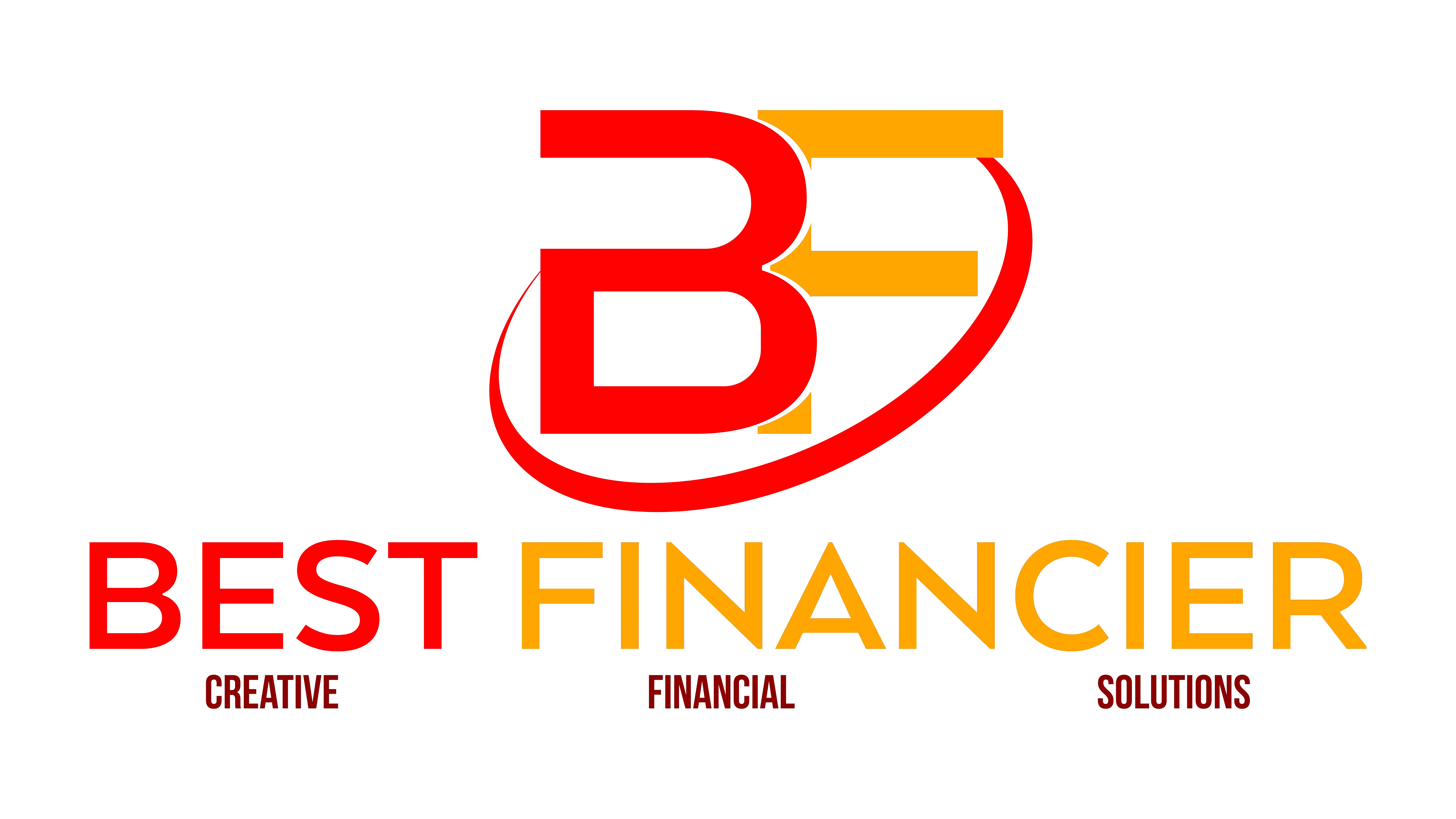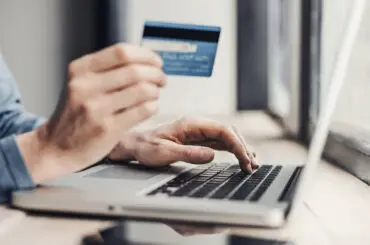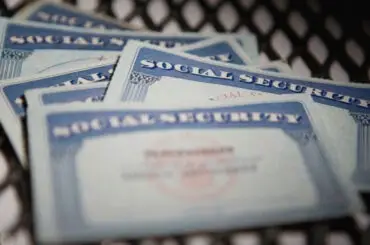Information presented on this web page is intended for informational and educational purposes only and is not meant to be taken as legal, financial, investment or tax advice. We do not accept any responsibility for any trading or investment related losses. Please review our disclaimer on before taking action based upon anything you read or see.
It’s typically simpler to maintain a count of the checks you make if you create carbon copies of them. A small piece of paper sits behind each check, recording the checks you create. This bank document typically contains your personal information, which might get you into problems if it falls into the wrong hands. Thus, we have made this article to show you how to dispose of check carbon copies.
You may also pick from several checks when you open a bank account. Paper checks have become less prevalent because of the accessibility of card payments, online banking, and internet payment systems. On the other hand, checks may help manage personal and family money.
A check is a written order to pay the bank for a certain sum from the drawer accounts. When buying paper checks, customers usually have the option of purchasing duplicate checks. Therefore, it’s advisable to understand how to dispose of these copies at this stage securely.
What are Check Carbon Copies?

In addition to the original check, a duplicate check contains a carbon copy. Duplicate checks function similarly to regular checks/single checks, except that each check is accompanied by a little bit of text. This thin paper has room for all check data, such as recipient, amount, and date.
Duplicate checks are required for business transactions because when a user begins writing on the original check, an equivalent copy is created on the plain paper underneath the check. This printed copy will assist you in keeping track of your money.
You can also utilize it in the future to reconcile your account or compare financial information. The writer must apply a little force to the entire check while creating a duplicate check. This will guarantee that whatever is written above gets duplicated.
Check carbon copies, like many other financial technologies, offer a variety of advantages and disadvantages. Come along as we highlight them below.
Advantages of Check Carbon Copies
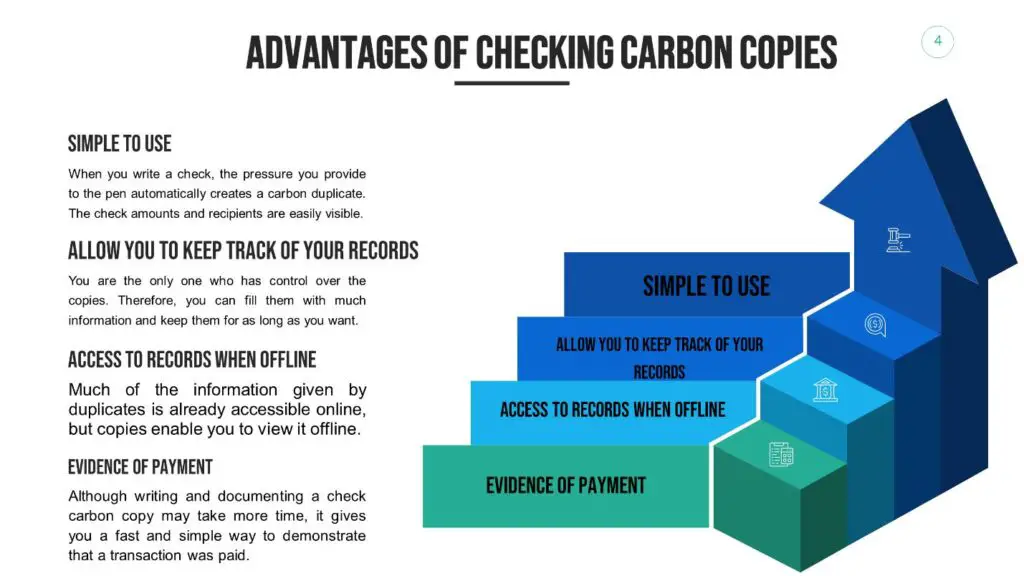
Disadvantages of Check Carbon Copies
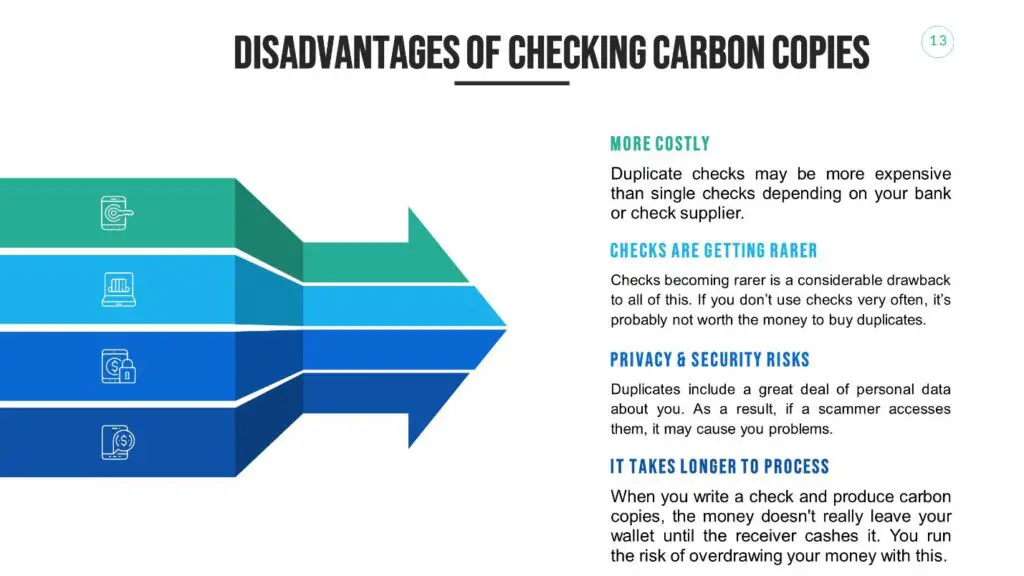
Advantages and Disadvantages of Check Carbon Copies: Tabular representation
The advantages and disadvantages of check carbon copies have also been highlighted in the table below:
| Advantages of check carbon copies | Disadvantages of check carbon copies |
| Simple to use | Much more costly |
| Allow you to keep track of your records | Checks are getting rarer |
| Access to records when offline | Risk to security and privacy |
| Proof of payment. | Payment Proof is not available. |
Why Disposing of Check Carbon Matters
Let’s be clear, there are numerous reasons one might choose to dispose of their old check carbon copies. There might be a bank account that has been inactive for a while. Or, it might be because you simply don’t need the hassle of having physical bank account copies lying around. Whether you prefer it or not, you should know how to dispose of check carbon in a way that minimizes the risk. It sounds a little sketchy, but it is entirely safe.
After all, if you don’t know how to dispose of your old check carbon, you’re taking a risk. And, if you don’t want to take any risks, there are several easy ways to dispose of your old check carbon.
How to Dispose of Check Carbon Copies | 15 Pro Methods

You can get rid of check carbon copies through the following ways:
- Burn the carbon copies
- Paper shredding
- Do Incineration
- Use of shredding services
- Soaking the check carbon copies in liquid
- Using scissors to shred
- Donate check carbon to charity
- Bury check carbon
- Destroy check digit copies
- Make a digital version of the check
- Pay early
- Invest your money
- Sell it
- Get a receipt from the bank.
- Deposit the check.
Burn the carbon copies
Paper is rendered unsalvageable when it is burned into ashes. Burning check carbon copies is a more efficient and secure method of destroying them. It’s one of the simplest and safest ways to get rid of your check.
However, burning check carbon copies must be done with extreme caution since a single out-of-control fire may bring many problems. It’s better to burn a single copy at a time in a firebox with no dry, combustible materials or as kindling in a fireplace.
A better choice would be to burn a single carbon duplicate piece by piece to avoid flare-ups and potential fire hazards. Burning a single leaf reduces the likelihood of a wildfire and improves control over the process of combustion.
Burning the check also eliminates any trace of carbon copies and essentially eliminates the danger of fraudsters and exploiters since no trace of the check remains.
However, it would be best to remember that untreated ash waste might be hazardous to humans and the environment. Thus, it should be appropriately disposed of when the check carbon copies have been reduced to cinders. When dealing with fire, it is imperative to use extreme caution too.
Paper shredding
Shredding is an effective method for getting rid of check carbon copies. A cross-cut shredder shreds the paper at many angles. This also ensures shredding it into tiny bits that can’t be put back together. It is a safe technique of disposal. Shredding is something that you may do at both households and companies.
Shredders are commonly seen in offices that create a lot of paper trash. After receiving authorization from their company, employees may quickly destroy their check carbon copies using the shredders.
Office supply businesses now shred checks on-demand in addition to these workplace shredders. For example, clients may shred small or large batches of paper at UPS and FedEx locations. These establishments also allow check owners to have their check carbon copies destroyed before their eyes.
This reduces the risk of tampering and is also relatively safe since these cross-cut shredding machines shred the paper into tiny bits that can’t be bonded together.
You can find a portable solution for home-use shredders on the market. The good news is that you can also find these shredders online at various rates. The disadvantage of these tiny, low-quality shredders is that instead of shredding the checks into little bits, they shred them into long strips.
A fraudster with access to the check holder’s details may reassemble these lengthy strips. To eliminate this risk, it’s best to cut the check’s details horizontally before running it through a domestic primary shredder. The strips will be narrower and even tinier due to this method. Thus, the odds of reassembling are drastically decreased.
Do Incineration
Another option for getting rid of check carbon copies is to incinerate them. It also removes all checks’ traces and is a safe and efficient method of destroying check carbon copies. In addition, the danger presented by swindlers to check owners is essentially non-existent after incineration.
Usually, incinerators are prohibitively costly and not viable for most limited check carbon copy disposal. On the other hand, incinerators may be used to dispose of vast volumes of check carbon copies.
Use of shredding services
It might take time to destroy each record separately if you have a stack of outdated check carbon copies. Several Office Depot retailers can destroy your old check carbon copies. This is valid as you watch at their in-store printing facilities, which often provide shredding as a feature.
Most banks and credit unions shred check carbon copies for their clients on demand or at times throughout the year. Banks and credit unions have strong shredders for their purposes.
Equivalent “shredding days” are provided by certain towns to their inhabitants. Ask for authorization to send a package of your old check carbon copies together with their shredder-bound paperwork. This will work well if your business utilizes a professional shredding provider.
Soaking the check carbon copies in liquid
Old check carbon copies may be disposed of in an eco-friendly way by being soaked in liquid. There are many liquids available for use in checking carbon copies disposal.
You can place them in a baking dish and cover them with liquids like water, vinegar, or bubbly soda. Wait a few days for the paper to thoroughly absorb the liquid.
The pulp created when the paper is broken down into liquid will resemble Papier-mâché.
It might take a few days to many days for check carbon copies to decompose into pulp. Typically, this is influenced by the soaking liquid.
Even though it takes some time for the material to break down, this disposal is efficient and secure.
Using scissors to shred
Another alternative for eliminating outdated Check Carbon Copies is to shred them using scissors. A cheaper alternative to using a shredder is to cut checks with shredding scissors.
Sharp perpendicular blades on shredding scissors allow for the quick destruction of up to ten check carbon copies at once.
Cut the portions containing crucial information using these scissors. Cut through your identity, account number, and location in particular.
The check carbon copies may be broken into pieces by cutting the shreds in the other direction. Since the fragments can’t be put back together, disposal is safer when scissors are used.
Donate check carbon to charity
Chances are, you’ve got a ton of old check carbon lying around, and you aren’t using it. Why not donate it to a charitable organization? Many charities like Habitat for Humanity accept check carbon as a way of depositing large amounts of money. You could also try donating it to a group that supports literacy, education, or health causes.
Bury check carbon
If you’d rather not deal with old check carbon lying around, you can always bury it. First, dig a hole that’s at least six feet deep. Next, find a secure place where nobody will stumble upon your old check carbon.
Destroy check digit copies
If you’re worried about disposing of your old check carbon, or you’ve tried everything else, try destroying the copies. There are a few ways to do this: First and foremost, you can shred the check and the carbon copy. Next, you can try crushing the check into powder using a hammer or crushing device.
Or, you can use a large magnet to pull the check and carbon copy together like a magnet to erase the magnetic ink. These are just a few ways to destroy check digit copies. If you want to get rid of them safely, you’ll want to ensure you’re doing it right.
Make a digital version of the check.
This is probably the most straightforward method to dispose of old check carbon. Simply scan the old check, make a digital version using an app like CheckiO or ChexSystems, and deposit it electronically.
Pay early.
If you have a large chunk of money to deposit, you can take it to your bank and pay them early. This will allow you to deposit the whole amount at one time instead of one by one.
Invest your money.
Many people wonder if they can invest their check carbon. And while it might be a little unconventional, it’s a great way to keep a steady flow of money.
Sell it.
You can try selling it if you’re looking for a quick and easy way to eliminate your old check carbon. Several websites specialize in this.
Get a receipt from the bank.
This receipt will help you if anything goes wrong—especially if you accidentally deposit a fake check. Contact the bank once you’ve verified the check is authentic. If something has gone wrong, you need to let them know as soon as possible.
Deposit the check.
If you do deposit the check, do it right then and there. That way, you have the receipt, and there’s no risk of someone forging a new check.
Why Dispose of Check Carbon?
Many people Dispose of Check Carbon due to the following reasons:
To Prevent Identity Theft
Data on your Check Carbon could be used to steal your identity. Your phone number and birthdate might have been added as well for comfort. An identity thief will need this knowledge to generate new accounts in your name.
A prospective identity thief may have access to even more data if you share the account with another individual and both have details on the Check Carbon.
To stop scams or fraud.
A malicious person can also use the details on your check carbon to persuade you that they are an authorized delegate of your bank or another institution, similar to how identity theft works.
They may use the fact that they already know some of your personal information to strengthen their case and persuade you to divulge even more.
To stop unauthorized access to your money.
A thief can use the information on your check carbon to gain access to the accounts you already own. Therefore, getting rid of check carbon will prevent unauthorized access to your money.
Frequently Asked Questions
How can you get rid of carbon copies of checks?
Check carbon copies may be disposed of in the following ways:
- Combustion
- Paper shredding
- Incineration
How do duplicate checks work?
Duplicate checks are bound in the same way as single checks. This permits them to fit in the exact location as your regular checks. Each check is accompanied by a tiny piece of paper that acts as a carbon copy. For reference, the copy has the same check number written on it.
The pressure from your pen transmits what you write to the replica when you write a check. You only pull off the check once you’ve written it, leaving the duplicate page connected to your checkbook.
You’ll always have a copy handy for quick reference. You’ll also have a record of everything you typed on the check, including the payee, amount, date, and memos.
Is it worthwhile to invest in duplicate checks?
Yes. Investing in duplicate checks is worthwhile, as they aid in seeing who you paid, how much you spent, and when you made the check. In addition, because the whole check is replicated, you can see whatever you’ve put elsewhere on the check.
How long should I keep checking carbon copies?
The amount of time you must maintain a canceled check or its carbon duplicate is determined by the payment’s purpose. For example, most check carbons may be thrown away after the check has cleared and your bank statement has been reconciled.
Conclusion
In conclusion, many individuals throw away their check carbon copies without thinking about the consequences of putting papers containing their personal information in the rubbish can. Scammers may retrieve this information from scattering papers, fabricate fictitious identities, and impersonate the check bearer. For the check owner, this impersonation might have disastrous implications.
The imposter may get loans and other financial services by utilizing their identity, making the owner accountable for any charges. As a result, it is critical to dispose of check carbon copies securely and adequately. To this end, the highlight on how to dispose of check carbon copies above will be indispensable for you.
My Personal Opinion
Your check carbon copies contain several key information, including your name, address, and account number. Some may also have additional details, such as your driver’s license or Social Security number, recorded by the cashier who took your check. These data points, combined with the staggering amount of online information, can make you an easy target for fraud or identity theft.
Even old check carbon copies on closed accounts can be problematic. Even modestly skilled criminals and scam artists can create fake accounts with those check carbon copies and a fake ID in your name. And this can potentially inconvenience you for years to come. Thus, it’s best to learn how to dispose of check carbon copies.
REFERENCES
- https://practiceadvices.com/data/advice/read/240890-is-it-safe-to-throw-away-carbon-copies-of-checks
- https://legalbeagle.com/13649191-how-to-recycle-rubber-bands.html
- https://money.stackexchange.com/questions/53804/what-is-the-best-way-to-dispose-of-old-checkbooks
- https://canyouthrowitaway.com/checks/
- https://www.cnbtn.com/2019/01/04/what-to-do-with-a-check-after-youve-done-a-mobile-deposit/
